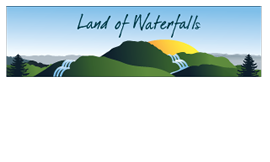The
Blue Ridge Parkway, originally called the Appalachian Scenic Highway, was
planned as part of Franklin Roosevelt’s New Deal program to help put Americans
back to work during the Great Depression.
Construction began in the fall of 1935 near the Cumberland Gap in
Alleghany County, NC.
Initially
the work was carried out by private contractors, as well as several public works agencies,
including the WPA (Works Progress Administration), ERA (Emergency Relief
Administration) and CCC (Civilian Conservation Corps),
In May
1937 the exact route of the southern section of the Parkway from Asheville to
the Great Smoky Mountains Park was still being discussed. Alternate routes were being considered to
reduce construction costs and to work with the Cherokee Indian Tribal Council
regarding the route through their lands.
One
proposal took the Parkway south from Mount Pisgah through the French Broad Valley
to Brevard before heading west to Sylva and Bryson City. Some in Transylvania County thought this
would be beneficial by bringing more people and tourism dollars through the
heart of the county.
However,
because that route was much longer and therefore less likely to be selected,
local officials advocated for the original route along the crest of the
mountains. The Wilderness Society
opposed this mountain top route as it would cross through an area that should
be protected.
In
August 1937 officials announced they would stick with the original route, providing the best scenic views. There was
a brief discussion about re-routing the Parkway closer to Mount Toxaway but
again it was decided to stay with the original route.
The
section from Wagon Road Gap to Balsam Gap was selected as the first part of the
Parkway south of Asheville to be constructed because it would link two existing
roads in Transylvania and Haywood counties.
This ensured there would be no dead end links on the Parkway before all
of its sections were completed.
At the
same time Highway 284, (today Hwy. 276) through the Pisgah National Forest was
being constructed. It was open to the
public in late 1938 and paved the following spring. Funding for the expansion and upgrading of
the Rosman-Sunburst Rd. (today Hwy. 215) was approved in July 1938, with work
beginning soon after.
Although
members of the Civilian Public Service program continued work on the Blue Ridge
Parkway during World War II the project was much delayed. At the start of the war the Transylvania-Haywood
section consisted of about five miles of paved road and a few stone walls.
An
article in the March 1954 Ecusta Echo states that, “The stretch of the Parkway
from Wagon Road Gap to Beech Gap, connecting with Sunburst Road, will be
finished this year.”
 |
| Work began in 1940 on the 660-foot long Devil’s Courthouse tunnel,seen here from the north side. |
From
the Little Pisgah Tunnel at mile marker 406.9 to Beech Gap at mile marker 423.3
the Parkway runs basically along the Haywood and Transylvania county line, crossing back and forth occasionally. There are three
additional tunnels along that stretch of the road—Buck Springs Tunnel, Frying
Pan Tunnel and Devil’s Courthouse Tunnel.
The
Parkway stretches 469 miles from Rockfish Gap, Virginia to the intersection with
Highway 441 just north of Cherokee, North Carolina. With the exception of 7.7 miles near
Grandfather Mountain the scenic road with completed in 1966. The final stretch, which includes the Linn
Cove Viaduct, was finished in 1987.
Photographs
and information for this column are provided by the Rowell Bosse North Carolina
Room, Transylvania County Library. Visit the NC Room during regular library
hours (Monday-Friday) to learn more about our history and see additional
photographs. For more information, comments, or suggestions contact Marcy at [email protected]
or 828-884-1820.



